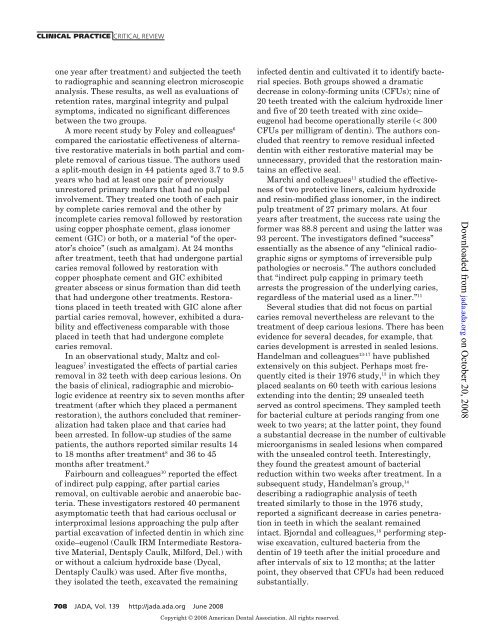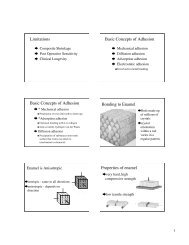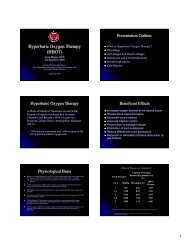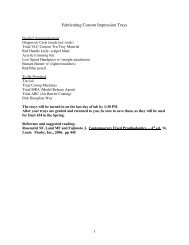Management of the deep carious lesion and the - Ohio State ...
Management of the deep carious lesion and the - Ohio State ...
Management of the deep carious lesion and the - Ohio State ...
Create successful ePaper yourself
Turn your PDF publications into a flip-book with our unique Google optimized e-Paper software.
CLINICAL PRACTICE CRITICAL REVIEW<br />
one year after treatment) <strong>and</strong> subjected <strong>the</strong> teeth<br />
to radiographic <strong>and</strong> scanning electron microscopic<br />
analysis. These results, as well as evaluations <strong>of</strong><br />
retention rates, marginal integrity <strong>and</strong> pulpal<br />
symptoms, indicated no significant differences<br />
between <strong>the</strong> two groups.<br />
A more recent study by Foley <strong>and</strong> colleagues 6<br />
compared <strong>the</strong> cariostatic effectiveness <strong>of</strong> alternative<br />
restorative materials in both partial <strong>and</strong> complete<br />
removal <strong>of</strong> <strong>carious</strong> tissue. The authors used<br />
a split-mouth design in 44 patients aged 3.7 to 9.5<br />
years who had at least one pair <strong>of</strong> previously<br />
unrestored primary molars that had no pulpal<br />
involvement. They treated one tooth <strong>of</strong> each pair<br />
by complete caries removal <strong>and</strong> <strong>the</strong> o<strong>the</strong>r by<br />
incomplete caries removal followed by restoration<br />
using copper phosphate cement, glass ionomer<br />
cement (GIC) or both, or a material “<strong>of</strong> <strong>the</strong> operator’s<br />
choice” (such as amalgam). At 24 months<br />
after treatment, teeth that had undergone partial<br />
caries removal followed by restoration with<br />
copper phosphate cement <strong>and</strong> GIC exhibited<br />
greater abscess or sinus formation than did teeth<br />
that had undergone o<strong>the</strong>r treatments. Restorations<br />
placed in teeth treated with GIC alone after<br />
partial caries removal, however, exhibited a durability<br />
<strong>and</strong> effectiveness comparable with those<br />
placed in teeth that had undergone complete<br />
caries removal.<br />
In an observational study, Maltz <strong>and</strong> colleagues<br />
7 investigated <strong>the</strong> effects <strong>of</strong> partial caries<br />
removal in 32 teeth with <strong>deep</strong> <strong>carious</strong> <strong>lesion</strong>s. On<br />
<strong>the</strong> basis <strong>of</strong> clinical, radiographic <strong>and</strong> microbiologic<br />
evidence at reentry six to seven months after<br />
treatment (after which <strong>the</strong>y placed a permanent<br />
restoration), <strong>the</strong> authors concluded that remineralization<br />
had taken place <strong>and</strong> that caries had<br />
been arrested. In follow-up studies <strong>of</strong> <strong>the</strong> same<br />
patients, <strong>the</strong> authors reported similar results 14<br />
to 18 months after treatment 8 <strong>and</strong> 36 to 45<br />
months after treatment. 9<br />
Fairbourn <strong>and</strong> colleagues 10 reported <strong>the</strong> effect<br />
<strong>of</strong> indirect pulp capping, after partial caries<br />
removal, on cultivable aerobic <strong>and</strong> anaerobic bacteria.<br />
These investigators restored 40 permanent<br />
asymptomatic teeth that had <strong>carious</strong> occlusal or<br />
interproximal <strong>lesion</strong>s approaching <strong>the</strong> pulp after<br />
partial excavation <strong>of</strong> infected dentin in which zinc<br />
oxide–eugenol (Caulk IRM Intermediate Restorative<br />
Material, Dentsply Caulk, Milford, Del.) with<br />
or without a calcium hydroxide base (Dycal,<br />
Dentsply Caulk) was used. After five months,<br />
<strong>the</strong>y isolated <strong>the</strong> teeth, excavated <strong>the</strong> remaining<br />
708 JADA, Vol. 139 http://jada.ada.org June 2008<br />
Copyright © 2008 American Dental Association. All rights reserved.<br />
infected dentin <strong>and</strong> cultivated it to identify bacterial<br />
species. Both groups showed a dramatic<br />
decrease in colony-forming units (CFUs); nine <strong>of</strong><br />
20 teeth treated with <strong>the</strong> calcium hydroxide liner<br />
<strong>and</strong> five <strong>of</strong> 20 teeth treated with zinc oxide–<br />
eugenol had become operationally sterile (< 300<br />
CFUs per milligram <strong>of</strong> dentin). The authors concluded<br />
that reentry to remove residual infected<br />
dentin with ei<strong>the</strong>r restorative material may be<br />
unnecessary, provided that <strong>the</strong> restoration maintains<br />
an effective seal.<br />
Marchi <strong>and</strong> colleagues 11 studied <strong>the</strong> effectiveness<br />
<strong>of</strong> two protective liners, calcium hydroxide<br />
<strong>and</strong> resin-modified glass ionomer, in <strong>the</strong> indirect<br />
pulp treatment <strong>of</strong> 27 primary molars. At four<br />
years after treatment, <strong>the</strong> success rate using <strong>the</strong><br />
former was 88.8 percent <strong>and</strong> using <strong>the</strong> latter was<br />
93 percent. The investigators defined “success”<br />
essentially as <strong>the</strong> absence <strong>of</strong> any “clinical radiographic<br />
signs or symptoms <strong>of</strong> irreversible pulp<br />
pathologies or necrosis.” The authors concluded<br />
that “indirect pulp capping in primary teeth<br />
arrests <strong>the</strong> progression <strong>of</strong> <strong>the</strong> underlying caries,<br />
regardless <strong>of</strong> <strong>the</strong> material used as a liner.” 11<br />
Several studies that did not focus on partial<br />
caries removal never<strong>the</strong>less are relevant to <strong>the</strong><br />
treatment <strong>of</strong> <strong>deep</strong> <strong>carious</strong> <strong>lesion</strong>s. There has been<br />
evidence for several decades, for example, that<br />
caries development is arrested in sealed <strong>lesion</strong>s.<br />
H<strong>and</strong>elman <strong>and</strong> colleagues 13-17 have published<br />
extensively on this subject. Perhaps most frequently<br />
cited is <strong>the</strong>ir 1976 study, 13 in which <strong>the</strong>y<br />
placed sealants on 60 teeth with <strong>carious</strong> <strong>lesion</strong>s<br />
extending into <strong>the</strong> dentin; 29 unsealed teeth<br />
served as control specimens. They sampled teeth<br />
for bacterial culture at periods ranging from one<br />
week to two years; at <strong>the</strong> latter point, <strong>the</strong>y found<br />
a substantial decrease in <strong>the</strong> number <strong>of</strong> cultivable<br />
microorganisms in sealed <strong>lesion</strong>s when compared<br />
with <strong>the</strong> unsealed control teeth. Interestingly,<br />
<strong>the</strong>y found <strong>the</strong> greatest amount <strong>of</strong> bacterial<br />
reduction within two weeks after treatment. In a<br />
subsequent study, H<strong>and</strong>elman’s group, 14<br />
describing a radiographic analysis <strong>of</strong> teeth<br />
treated similarly to those in <strong>the</strong> 1976 study,<br />
reported a significant decrease in caries penetration<br />
in teeth in which <strong>the</strong> sealant remained<br />
intact. Bjorndal <strong>and</strong> colleagues, 18 performing stepwise<br />
excavation, cultured bacteria from <strong>the</strong><br />
dentin <strong>of</strong> 19 teeth after <strong>the</strong> initial procedure <strong>and</strong><br />
after intervals <strong>of</strong> six to 12 months; at <strong>the</strong> latter<br />
point, <strong>the</strong>y observed that CFUs had been reduced<br />
substantially.<br />
Downloaded from<br />
jada.ada.org<br />
on October 20, 2008






